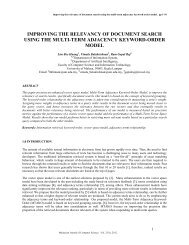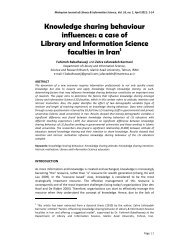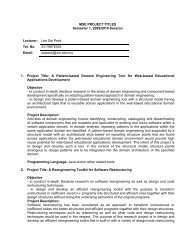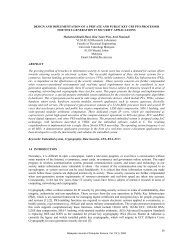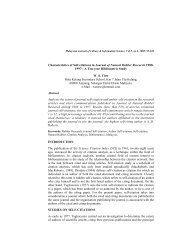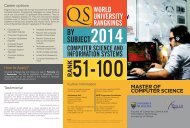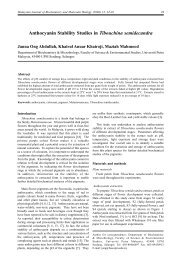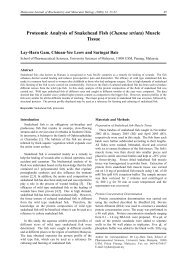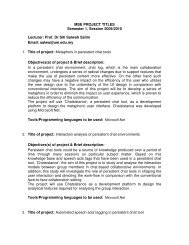Download1 - EJUM - Universiti Malaya
Download1 - EJUM - Universiti Malaya
Download1 - EJUM - Universiti Malaya
Create successful ePaper yourself
Turn your PDF publications into a flip-book with our unique Google optimized e-Paper software.
DISSERTATIONS/THESES UNDERTAKEN AT THE FACULTY OFDENTISTRY, UNIVERSITY OF MALAYA FOR THE YEAR 2009The Effect of some Denture Cleansers onthe Properties of Three Auto PolymerizedSilicone Den.ture LinersOmar. Tarik AlirhayimDepartment of Prosthetic DentistryA study was carried out to assess weight changes andsurface quality in three auto polymerized silicone softdenture liners; GC(Soft and extra soft, GC, Japan) andMollosil plus (Detax, Germany) after immersion in·different denture cleansers; Polident (GlaxoSmithKline,Ireland), Steradent (Reckitt & Colman., UK), Protefix(Queisser Pharma, Germany) and one disinfectant;Perform (Schulke & Mayr. Asia Ltd.).The soft lining materials were mounted on theprepared acrylic resin disc of 14 mm diameter and 2mm thickness (Meliodent, Heraeus Kulzer, Germany),n ~ seventy five. Five specimens from each of softliners were immersed in each denture cleanser and one, disinfectant for 8 hours; this represented the normalovernight cleansing regime. Fresh solutions of-denturecleanser and disinfectant were prepared each day andfollowing the immersion period, the specimens werestored in tap water at 37°C for the remainder of 24-hour period (24 -8 = 16 hours). This procedure wasrepeated 'for 60 days with the interval of 3, 7, 14, 28and 60 days. The control specimens were stored in tapwater at 37"C. Sorption was expressed as a percent ofweight loss or gain compared with the weight of theinitial sample by using digital electronic balance :.(Sartorius, Germany).Repeated measu~s_ analysis of variance (ANOVA)procedure, Post Hoc Tukey's test, paired sample t testand Bonferroni correction were conducted to test thenull hypotheses about the effects of both the subjeCtsfactors and the within factors. The results of theanalysis indicated that there was a significant effect (P< 0.04) in terms of weight gain for immersion periodand there is a significant interaction effect forimmersion period by-material and immersion periodby-denture cleanser:The sorption in the soft liners was significant after60 days (P < 0.04) of immersion in the denturecleansers and disinfectant, which is time dependent.The correct combination of soft liner and denturecleanser is critical to ensure optimum life span of thelining.Attitudes and Experience of GeneralDentists in Providing Oral Healthcare forChildren with Special NeedsDr. Norliza IsmailDepartment of Community DentistryQral healthcare is the most prevalent unmet health careneed for children with special needs (CSN). The lackof health care professionals who are trained,experienced, and willing to provide treatment are someof the barriers in the provision of a comprehensive carefor this group of children.The aim of this study is to determine the attitudesand experience of general dentists in providing oralhealthcare for C~N. A descriptive cross-sectional studywas carried out among all general dentists in Selangorand Kuala Lumpur. Self-administered questionnairewas used for data collection. The final samplecomprised of385 particip~nts, with a response Tate of82.1 % (n= 165) for public dentists and 34.1 % (n=220),' .for p'rivate dentists.The results showed that the majority)'90%)reporteCl experience and willingness in pr9viding. carefor CSN with a'significantly higher pro'portion amongthe public dentists, younger age groups (40 and below)and those with less than 10 years of practice (p
44 Annals af Dentistry, University af <strong>Malaya</strong>, Val. 16 2009Smoking Habits among Dental Personnel inPahangDr. Maryana MusaDepartli1fnt of Community DentistrySmoking is a worldwide problem. Being dentalpersonnel do not exclude them from engaging into thishabit. The aim of this study was to investigate thesmoking habits among de~tal personnel in the state ofPahang using a self-administered questionnairefollowed by a Nominal Group Technique discussion.The objectives of this stu'dy were to investigate theprevalence of smoking habits among dental personneland its association with socio-demographic factors, toinvestigate the association between knowledge, attitudeand smoking habits and to evaluate the impact of the"Smoking Cessation Programme".A total of 728 out of 780 dental personnelrespopded to- the questionnaire giving a response rateof 93.3%. The prevalence of current smokers was13.8% (n=100) and was significant,ly associated withethnicity, location (p=O.O 18), gender, occupati'on,education level and income (p
Dissertations/Theses 45DAI be used as a screening tool by dental nurses in theschool dental service as it can act as a safety net andensure that students in need of orthodontic treatmentare not left out. Dental officers can be trained to usethe IOTN as the next level of referral to re-check thestudents using the DHC of the IOTN before referringthem to the' orthqdontists. This would ensure a moreobjective system referral and tho.se in great need fo~treatment are ploi9ritized accordingly and given timelyintervention ..Dental status and combat readinessassessment of Malaysian Armed Forcesinfantry soldiersDr. Amrizan Abdul WahidDepartment of Community DentistryThe aims of this study were to assess the dental status,dental combat readiness and related oral health.behaviours of the infantry soldiers after five years ofactive military service. The objectives were to evaluatethe progression of dental caries using the DMFT andDMFS index, their current oral health practices andbehaviours, and the dental aspect of combat readinessin five infantry battalions of the Malaysian ArmedForces. This study was a combination of cross-sectionaland retrospective studies using a self-administeredquest(onnaire followed by an oral examinationinvolving 173 soldiers who had completed five yearsof activ~ service. The soldiers were taken from fiveinfantry battalions by using the total sampling method.The response rate was 67.3%.The pi"evalence of caries (DMFT 2:. 1) ha'dincreased by 3.8% within 5 years (2008 = 79.8%, 2002/03 = 76.9%). Th~r§ was a decrease in mean DT (4003= 1.7,.2008 =1.3), an increase in mean MT (2003 =0.5,2008 =1.1) and mean.:FT (2003 =1.3; 2008 =1.6).The prevalence of active caries (DT) was slightlyhigher at recruitment (59%) than in 2008 (54.9%)indicating that treatment was done to treat the activecaries. DMFS .had increased by 63.6% sincerecruitment with the biggest changes seen in the MScomponent where it had increased by 129.2%.According toCDENTAP~2008 system, only 40.5%of the total subjects were dentally fit. The prevalenceof dental pain was 34.1 % and toothache was cited asthe main cause (91.5%). The impacts of dental painwere feeling worried (91.5%), sleep disturbance(62.7%), work disturbance (59.3%), chewingdisturbance (66%) and social disturbance (37.3%).However, on the examination day, the majority ofrespondents (91.9%) did not experience any dental.pam.All subjects (100%) reported brushing their teethdaily. The majority (62.4%) used fluoride toothpaste.However, only 1.7% flossed their teeth. About 42% ofthe total sample attended a dental clinic in the past oneyear prior to the study. Out of these, 53.4% wentbecause of dental problems. More than one-half(54.3%) went to military dental clinics on their lastvisit. Smoking prevalence was very high (85%), withmean number of cigarettes/day of 10.0( (SD= 4.8).Only 7% of subjects consumed alcoholic drinks.It was concluded that the current dental status ofthe infantry soldiers was better than during recruitmentin 2002/03 in terms of decreased mean DT. However,the mean number offilled teeth (FT) and missing teeth(MT:)-had also increased. The dental combat readinessaccording to DENTAP 2008 classification was lowwith more than one-half of the subjects who neededdental treatment prior to deployment.It was recommended that MAF make policy. changes to promote the oral health of the infantrysolCliers such as improving the dental attendance,providing a dental kit as part of Full Service MarchingOrder (FSMO) and organizing oral health promotionprogrammes to reduce oral diseases and improve oralhealth related quality of life of the infantry soldiers.Epidemiology of Tt:aumatic Dental Injuriesa~ong AdolescentsDr. Sofiah Mat RipenDe,Partment of Community D,ent;istryThe aim of the study wa's to measure the prevalenceof traumatic dental injuries (TDI) to permanent anteriorteeth in adolescents, to determine the causes of TDI,to identify r~asons for the untreated injured teeth andthe impact of untreated injured teeth on Quality of Lifeamong 13 and 16-year-old schoolchildren in Klangdistrict.A cross-sectional study was carried out in a sampleof4602 schoolchildren. The children were, clinicallyexamined and children with TDI ~ere given a selfadministeredquestionnaire.The prevalence of traumatic dental injury was5.0%. Males (6.8%) had TDI levels approximatelytwice as high as females (3.0%). Indians experienceda higher TDl levels than other ethnicity. Maxillarycentral incisors were the most common teeth with TDI.Most of the affected children (77.2%) had trauma to 1tooth. Enamel fracture (42.4%) was the major type ofTDI. The main cause of injury reported was fall. (62.7%). Most of the TDl occurred at home (52.2%).A total of 288 teeth were traumatis'ed with 84.4% ofthe traumatised teeth not treated. About half of theparticipants "do not care" about the appearance of theiruntreated traumatised teeth. The impact of untreated. traumatise teeth on Quality of:Life among adolescentsin Klang was found to be between low to moderate.In conclusion, the prevalence of TDI amongadolescents in Klang is low and the impact oftraumatised teeth 0!1 the Quality of Life amongadolescents is found to be low to moderate.
46 Annals of Dentistry, University of <strong>Malaya</strong>, Vol. 162009Tooth Brushing Practices and Oral HealthImpacts among Bangladeshi UrbanAdolescents.,I Dr. Md. Tafazzul IslamDepartment of Community DentistryThe aim, of this study was to investigate tooth brushingpractices and oral health related quality. of life(OHRQoL) of adolescents aged 14-15 years oldattending schools in Sylhet city.A cross sectionfll study design was used. Aconvenient sample of 751 respondents aged 14-15 yearold from 6 secondary schools in Sylhet city wererecruited for the study.S-OHIP (M) was used to determine Oral HealthRelated Quality of Life of children. Data collection wasconducted by distributing self administeredquestionnaires among the children.Almost all respondents (95%) brushed their teethusing toothbrush and toothpaste and they owned atoothbrush (98%). Majority (7Q%) of the respondentsbrushed their teeth twice d,aily and used fluoridatedtooth paste (53%). However, about half (42%) of therespondents were unaware whether their toothpastecontained fluoride. Most respondents (95%) learnedhow to clean their mouth and teeth from familymembers. Comm(.lilly reported oral impacts were"toothache" (71%), "felt uncomfortable due"to food, getti.ng'stuck in between teeth or dentures" (66%),)'discomfort during eating any f9od'; '(48%), "d.ifficultyin chewing" (42%) and "concentration bee,n disturbed"(38%). The number of respondents who "very" or."quite often" experienced oral impacts was very smallfor all types of impacts. However, about 11%frequently (very or quite often) experienced toothachewhile 18% were sometimes affected. The associationsbetween frequency of tooth brushing and the following5 oral impacts were' found to be statistically significant:halitosis (p=0.005), sleep disturbed due to problems intheirmouth (p=O.O18)Jeel uncomfortable due to foodimpacted in between their teeth (p=0.025); ulc~rs in themouth (p=0.039), and feeCshy due t~ problems in th.eirmouth (p= 0.047).Most adolescents in Sylhet City clean their teethwith tooth brush and toothpaste. However, many donot know about fluoride toothpaste. Fa!llilies play animportant role in the maintenance of oral hygiene.Tooth ache and oral discomfort were more commonimpacts. Those who brushed at least twice daily wereless likely to have oral impacts compared to those whobrush only once daily.Oral Health Status and impacts amongFirst Year Cadets of National DefenceUniversity MalaysiaDr. Mohd. Rosli MajidDepartment of Community Denstistry ~ ..The aim of the study was to-determine the oral healthl ~status and oral health impacts among UPNM first year.cadets. The objectives of this study were; (1) to assess lthe perceived oral health status, satisfaction with oralhealth and perceived need., for treatment among first.year cadets in UPNM, (2) to assess their level of caries'(DMFS), (3) to assess thei~ level of periodontal disease(CPI) and (4) to assess the oral health impact of oraldiseases in the group by using the Oral Health ImpactProfile (OHIP). This is a cross-sectional survey of theUPNM first yea~. cadets where data was obtainedthrough oral examination (DMFS and CPI) and selfadministered questionnair~ survey (about demographic,perceived oral health, satisfaction with oral health,perceived treatment need and Oral Health Impact).Three hundred and thirty UPNM first year cadets inSg Besi campus were involved in this study.The prevalence of caries free ,and periodontallyhealthy subjects were 40.6% and 5.8% respectively. Themean DMFS was 3.07 of which 16.3% is accounted forby decayed surfaces. Females had higher DMFS thanmales. Nine out of ten cadets had calculus present and16.7% required complex periodontal treatment.Overall, 36.7% of the subjects had often or very oftenexperienced at least one oral health impact due to teeth,mouth, and denture problem. The three OHRQoLdomains most commonly affected were functionallimitation, physical pain and psychological di.scomfort.Social disability had the lowest domain impact amongthe cadets. The impacts which were very often or quiteoften experienced by the subjects were discomfort dueto food getting stuck (24.8%), had ulcer (9.7%) andbad breath (5.8%). Cadets who were free from oraldi~eases (caries and periodontal diseases) had lesseroral health impact. 75.5 % of them perceived theyneeded dental treatment and it significantly related withcaries status and OHRQoL.It is concluded that there is low level of caries, highlevel of periodontal diseases and moderate oral healthimpacts among the cadets. It is recommended thathygienist be stationed in UPNM to assist dentist tomanage the high level oi.periodontal problemsencountered...
Dissertations/Theses 47The effect of abutment angulation onstresses in bone: A 3-dimensional finiteelement studyDr. Muraja Afif UthmanDepartment of Oral and Maxillofacial SurgeryAims: To evaluate the effect of variations in implantabutment angulation on the intensity and distributionof von Mises, tensile and compressive stresses in thebone surrounding an implant using three-dimensional(3-D) Finite Element Method.Methods: 3-D FE models were constructed usingFE software (Pro/Engineer, Wildfire 2.0 parametrictechnology Corporation). The implant fixture was·modeled following Ankylos® system (Dentsply'Friadent, Germany); 3.5 mm in diameter and 11 mmin length, restored with an all-ceramic crownrepresenting the mandibular second premolar. The bonesegment was modeled to approximate the bonedimensions in the region of mandibular secondpremolar. Two situations of implant placement wereinvestigated. Group A represented distal tilting of theimplant in various angulations: 15°, 22.5°, 30° and37.5° and the abutments angled correspondingly so thatthe crown was in similar axial direction. Toaccommodate the abutment, the distal crestal bone was'beveled to level the implant head with the crestal bone.Group B represented a-nother clinical situation, in.which the implant was placed along the long axis ofthe bone while the bone segment was inclined buccallyat various angulations: 15°,22.5°,30° and 37.5°. As inprevious models, corresponding angulated abutmentswere used so that the crown was always loaded insimilar axial position.The control gro~p of this study was a straightimplant and str2:~ght,abutment placed vertically in thece~tre of the hone segment. A 3-D tetrahedral meshwas generated for alt.models constructed. Occlusalloads of 150 N were applied aXIally to the buccal cuspand distal fossa, giving a total load of 300 N for allmodels, to simulate occlusal loading during function.ANSYS versiop 11.0 (ANSYS/Workbench, Ansys Inc,USA) was used to provide the loading simulation andstress pro.file analyses. Results: For the co"ntrol group,stresses (comptessive, tens-ile) were seen concentratedaround the implant collar at the cortical bone. Stresseswere more homogenous in nature surrounding theimplant body and apical area.There was an increase in all types of stressesaround the implant collar in the cortical bone whenincreasing the abutment angulation for both groups.The highest compressive and tensile stresses for theGroup A models were -96 MPa and 60 MJ;>a"respectively, which were observed on the cortical bonearound the implant collar. A high level of compressivestress (-40 MPa) was observed. For the 37S modelwhere the distal cortical bone was cOffi.pletely removedto accommodate the abutment, the Group B modelsshowed -80 MPa and 64.5 MPa for the highestcompressive and tensile stresses respectively.Conclusions: Within the limitations of the presentstudy, the following conclusions were drawn: 1)Stresses appeared to concentrate at the cortical bonearound implant collar for single implant that wasloaded at buccal cusp and distal fossa. The stressesaround the implant body and apical area were relativelylow and homogenous. 2) Stresses increased with-increased abutment angulation for both groups. When37.5° model was used, the stresses increased nearlythree folds. 3) Removal of cortical bone at distal aspectfor 22.5°, 30° and 37.5° models of group A, resultedin high levels of compressive stress at the cancellousbone which may predispose the bone to micro fractureana resorption when they exceed the elastic limit ofbone. 4) Group B, particularly 37.5° model, showedtensile stress higher than the elastic limit of bone,which may undergo microfracture and resorption.Condylar sagittal path angle in selectedMalay females .Ammar Jasim Ali Musawi• Department of Prothetic Dentistry-' .IPURPOSE: To investigate the condylar path angle(CPA) in Malay females, compare the measurementsobtained with the average values (25°-35° Campers)and compare the right condylar path angle with the leftcon-dylar path angle.MATERIALS AND METHODS: A total of thirtysubjects were chosen according to a selected criteria,impressions of arches were made using a washtechnique with silicone regular body over silicone puttytype. Casts were poured into type IV diestone andfacebow transfer was taken for each subject. Casts weremounted to their centric position on Ka Vo Protar evo9 semi-adjustable articulator. Protrusive guides wereconstructed on the anterior teeth of the casts to allowthe mandible to be protruded for 5 mm, then the anglesmeasured using protrusive record method with siliconebite registration material.RESULTS: Within the limitation of this currentstudy, for the right angle it was found that 13 subjects(43.33%) were witltin the range of the average value(25°-35° Campers) and 17 subjects (56.66%) were outof range of the average value. Furthermore, themeasurements for the left angle 10 subjects (33.33%)were found to be in the range of the average value and20 subjects (66.66%) were .out of range. There was nostatistically significant diff~rence 'between the left andright condylar path angles. There was a strong linearrelationship between left and right condylar path anglesamong the Malay females.
48 Annals af Dentistry, University af <strong>Malaya</strong>, Val. 16 2009SUMMARY: The Malay females are notconsidered as an ethnic variation in regards to CPA,they can be treated the same way as the Caucasian~ inregards to that angle. CPA should be considered inconstructing fiX:~d and/or removable pro~thesescombined with the use of semi-adjustable articulators;this would enhance and improve the quality of thetreatment given to the patient. Clinicians should notdepend on the average values to which the simplearticulators are set. .Protrusive record method for programming thesemi-adjustable articulators can be reliable if modifiedby using efficient bite registration material and makingit reproducible by making use of the protrusive guide.Prevalence of Risk Factors for theDevelopment of Oral Mucosal Lesionsamong Or,ang AsH in MalaysiaIntan Suraiya Merican Aljunid MericanDepartment of Oral Pathelogy,Oral Medicine and ~eri~dontologyRisk habits such as smoking, alcohol'consumption andbetel quid chewing have long been identified asprimary risk factors in causing many'severe diseasesand cancers, Glutathiony S-transferase (GST), a PhaseII enzyme, is important in the detoxification andex~retion,ofmany carcinogens. Amorig the major GSTsfamily, GST - mul (GSTMl) had attracted r~searchersto conduct studies to establish the f~le of GSTMI in, the detoxification of carcinogens especiapy, fromcigarette smoke. There are contradictory reports on theassociation between the oral cancer related risk habits(smoking, betel quid chewing and alcohol drinking)with GSTMI polymorphism (null genotype). There arecurrently no studies on the prevalence of oral cancerrelated risk habits and oral mucosal lesions/conditionsavailable on the indigenous people of PeninsulaMalaysia namely the Orang Asli. There is, also little orlack of information on 'the prey'alence of' genepolymorphisms or its influence on the associatio~ ofdiseases and risk habits among"this populations,Aim: To determine the prevalence and describe thecommonly used preparation/ingredients of oral caneerrelated risk habits (smoking, betel quid chewing andalcohol drinking); to determine the pre~alence efrelated oral mucosal lesions and prevalence of GSTMI'polymorphism (null genotype); and to investigate the,association between risk habits and oral mucosal lesion'among those with and without GSTMI polymorphismin a selected group of Orang Asli of Peninsula MalaysiaMethods: This is a cross-sectional descriptivestudy with convenience sampling of Orang Aslivillagers from southern Peninsula Malaysia. Thesociodemographic information was collected using astructured questionnaire and a face to face interview.Subjects had their mouth examined and cells of buccalmucosa for DNA extraction were collected usingcervical cytobrush. Multiplex PCR was used todetermine GSTMI polymorphism (null genotype).Where relevant, the chi-square test of associations wascarried out using the SPSS version 14.0. The alphavalue for test of significance was set at p=0.05.ReSults: A total of 242 Orang Ash wereinterviewed and the, prevalence of smoking in thispopulation was 55.0% (133/242)'; alcohol drinking was4.1 % (10/242); and betel quid chewing was 19.8% (48/242). Males were more likely -to indulge in smokingand alcohol drinking compared to their femalecounterparts (p=O.OOOand p=0.005 respectively). Thesubjects commonly smoked commercially madecigarettes and' the 'rokok daun'. The most commonbetel quid-ingredients used by the bet~l-quid chewerswere dried ripe areca nut, betel-leaf and lime with fewadding 'gambir' to the quid which are commonlyplaced in the buccal sulcus. Only 159 subjects allowedexamination of their mouth and the prevalence of oralmucosal lesion/conditions (namely leukoplakia, oralsubmucous fibrosis, chewer's mucosa, lichen planusand other lesions) was 8.8% (14/159). Out of 159subjects with buccal cells collected, DNA from only 98subjects was of good quality for laboratory analysis.The overall prevalence of GSTMI polymorphism (nullgenotype) was 32.7% (32/98). Among subjects withlesions and GSTMI polymorphism (null genotype),33.3% smoked 1-10 cigarettes per day with 66.7%having smoked for >20 years; while among subjectswith lesions and without GSTMI polymorphism (nonnullgenotype), 83.3% smoked 1 to 10 cigarettes perday with 50% have been smoking for >20 years. Forthe betel-quid chewers, among those with lesions andGSTMI polymorphism, 33.3% each were chewing 1-5,6-10 and >10 quids/day with 100% having chewedfor a duration of 1-20 years; while among those withlesions and without GSTMI polymorphism, 50% werenon-chewers and 50% chewed 1-5 quids per day with33.3% and 16.7% have been chewing for 1-20 and >30years respectively. All the alcohol drinkers had no oralmucosal lesions.Conclusion: Smoking was the most common riskhabit in this Orang Asli population.' The prevalenc,e oforal mucosal lesion in this population was 8.8% andof GSTMI polymorphism (null genotype) was 32.7%,No trend was observed betw~en risk habits and oralmucosal lesions in those with' and without GSTMIpolymorphisms. In view of the small sample size, thisfinding cannot be generalized until a larger study isconducted.
Dissertations/Theses 49Effect of Porosity and Thermocycling on number of the porosity in the specimens ofCompressive Strength of Selected Luting encapsulated cements were greater than those of handmixedcements. 3. Mixing method has no effect on theCementscompressive strength. 4. The porosity (1-100) 11mindiameter and the compressive strength bore no linearDr. Aws Hashim Ali AI-Kadhimrelationship to each other. 5. The effect ofDepartment of Conservative Dentistrythermocycling on the compressive strength of lutingcements differed considerably with respect to theirThe purpose of this in vitro study was to evaluate thechemical compositions.effect o(por.osity of diameter (1-100) 11m, andthermocycling on the compressive strength of selected _luting cements.Materials and methods: A total of thirty cylindrical Porphyromonas gingivalis FimA type I andspecimens 6mm height and 4mm in diameter were II genotypes in Malay periodontitis patients':prepared for each type of cement which are RelyXTMARC (3M ESPE, USA), Fuji 1 (GC Corp, Tokyo,Abdulr3,hman Rashad Mohamed AI-AlimiJapan), Fuji I CAPSULE (GC Corp, Tokyo, Japan),Department of Oral Pathology, Oral MedicineFuji CEM (GC Corp, Tokyo, Japan) and Fuji PLUS':. and PeriodontologyCAPSULE (GC Corp, Tokyo, Japan) and were dividedinto two subgroups. Both groups were stored in Introduction: P gingiva lis (Pg) is a gram-negativedistilled water at 37°C for 24 hours, but one group were anaerobe ,associated' with periodontal diseases includingthen subjected to 500 cycles in baths of 5°C and 55°C adult periodontitis, generalized juvenile periodontitis,with 20 seconds of dwell time for each bath. The periodontal abscesses, and progressive periodontitis. Acompressive strength for each cement type was number of investigations studied -the association of thedetermined using the universal testing machine genotypes of fimA ,of Pg with periodontal conditionsSHIMADZU (SHIMADZU Corp, Tokyo, Japan). The " in many ethnic groups. The present study is a' c'rosssectionalstudy conducted on a Malay ethnic populationfractured surfaces of 10 randomly selected specimensfor each group of cement type were examined usi~g with periodontitis, who were matched by ethnicity andScanning Electron Microscopy (SEM) at 250 times corilpar~d,to healthy participant~. 'imagnification, and five photomicrographs were taken Objectives: The objective of this study was toat. five random places for each fractured surface. All determine the prevalence Pg fimA type I and IIthe photomicrographs were analyzed using an image genotypes in a Malay ethnic group and to relate thisanalyzer software to determine the amount and size of presen'ce to chronic periodontitis.porosity present. The data were analyzed by Kruskal- , Materials and Methods: A total of 30 MalayWallis and Mann-Whitney tests for compressive subjects (15 periodontitis and 15 periodontal healthystrength and percentage of porosity, Spearman?s rho subjects) aged 25 years and above were selected for thetest was used to examine the correlation between the current study. All consented subjects received detailedcompressive ,strength and the percentage of porosity (I- information sheets concerning the nature and theIQO) 11min diameter and Mann-Whitney test was used procedures involved in the study. Periodontitis subjectsto determine the :,:effect of thermocycling on were selected if they possessed pockets depth of 2.5 mmcompressive strength of these selected luting cements at 2.4 sites. Healthy subjects had probing pocket depthsResults: Resin adhesive cement has the highest :::;:3mm and no evidence of attachment loss. Clinicalcompressive strength, followed by conventional GIC parameters such as plaque (PI), bleeding (BI) andand resin mpdified GIC has the least. Mechanical gingival (GI), indices, probing pocket depth (PPD), andmixing method had no effect on the ,compressive probing attachment loss measurements were scored forstrength. Bu~ it had a significant effect by increasing each subject. The number of missing teeth were alsothe percentage of porosity of diameter (1-100) 11min noted. Subgingiva:l plaque samples were taken from thediameter of GIC and Resin modified GIe. There was deep pocket 2.5 mm in periodontitis subjects and fromno linear relationship between compressive strength areas without bleeding upon probing in healthyand porosity (1-100) 11m in diameter for all luting subjects. Pg fimA types I and II was identified bycements which were used in this study (P>0.05). polymerase chain reactiorl followed by gelThermocycling had no significant effect on electrophoresis.compressive strength of RelyXTM ARC and Fuji I Results: Pg was more prevalent in subjects with(P>0.05), but a significant effect on Fuji I CAPSULE, periodontitis (26.7%) a~ compared to the healthyFuji CEM, Fuji Plus CAPSLUE (P
50 Annals of Dentistry, University of <strong>Malaya</strong>, Vol. 16 2009individuals were shown to harbor fimA type I and IIbacteria almost equally in each category of probingpocket depth and attachment loss measurements.However, type 11detection was higher than type 1 in .both these ·measurements. Both genotypes of bacteriawere found only in pocket depths of more than 3 mm.For the GI, BI and PI categories, both genotypes of Pgwere associated with these indices. The frequency ofgenotype fimA type 11 was greater where plaqueaccumulation was greater (> 1)..Conclusions: Pg was detected in periodontallydiseased and healthy subjects. However it was morepredominant in the diseased subjects. PgfimA genotype1 was prevalent in both groups. Pg fimA genotype 11was identified in diseased subjects only. Pg wasassociated significantly with all clinical parameters,except for plaque index and missing teeth. Pg positivefimA genotypes 1 and 11had no significant relationshipto all clinical parameters.Immunolocalization of WNT-l ..in differentclinicopathologic subtypes ~fAnieloblastomaChuah Kee SengDepartment Oral Pathology, Oral Medicineand PeriodontologyBackground: Ameloblastoma is a histological benign,but 10callya,ggTessive non-encapsulated tumor arisingfrom' the odontogenic ectoderm and its derivatives.Despite it being classified as a benign odontogenictumor, the ameloblastoma shows a high tendency of. 'iecurrence and occasional.1y produces metastases.Ameloblastoma is classified into four ciinical types:unicystic, conventional or multi cystic, peripheral andmalignant. Histologically, there are two basic growthpatterns, follicular and plexiform. Wnt-l (Winglesstype protein), belongs to a 'large ~family of 19 secretedglycoprotein that act as signaling transducers thatpromotes cell proliferation and devefopment. Wntprotein signaling pathway plays an important key rolein carcinogenesis and embrYGgenesis. Previou·s.experimental data has shown over
Dissertations/Theses 51(version 11). For better visualization of minute canaldetails such as apical deltas, data was transferred toanother computer with Simplant software.Results: Most of the mandibular 1st molars hadtwo separate roots (99.4%). Fusion of roots inmandibular 1st molars occurred in 5.8% of the sample.In maxillaJ;'y molars, all the teeth were three rooted.Ghassan Mutaher Abdullah AI-IryaniDepartment of Oral and Maxillofacial SurgeryConclusion: P53 and Ki-67 expression can notprovide a prognostic value in regard to the predictionof lymph node metastasis in OSCe. Never the less, thesize of this sample does not allow a confident exclusionof other variants that might have come to participate,specifically heterogeneity of SCe.Fusion occurred mainly b.etween DB and MB roots(8.9%). ''[-~e prevalence of root curvature was high in Basement membrane profile of keratocysticboth type~ of t~eth. In mandibular mo.lars, tYl2e IV _ odontogenic tumourcanal cnflguratlOnwas the commonest III M roots. In -.maxillary molars, type I was the domiqantconfigurations in all the three roots. Lateral canals werecommonly found in M roots in mandibular molars andMB roots in maxillary molars. Centrally plac'ed apicalforamen was the most prevalent position in all the rootsstudied.Conclusion: CBCT proved a very reliable and noninvasivemeans of getting information on canalanatomy on extracted teeth. Root and canalmorphology of Kenyans 1st permanent molars showedsome variations and complexities as compared to thoseof other races. These should be considered when oneis treating Kenyan patients especially duringendodontic procedures.Association of KI-67 and P53 expressionwith cervical lymph node metastasis in oral~quamous cell carcinomaIntroduction: TNM staging has been consider.ed,regardless of its limitations, the most reliableprognostic,Jactot for oral squamous cell carcinoma(OSCC). The cervical lymph nodes status (N) impliesa significant prognqstic value. The aim of this studywas to correlate the incident of cervical lymph nodemetastasis with P53 and Ki-67 expression.Materials and Methods: The sample consisted of23 (11 tongue and 12 buccal mucosa) SCCs. Twospecimens representing the Tumour tissue and a clearmargin of each case were selected to undergoimmunohistochemical~ staining. Expression pf P53 andKi-67, represented as a percentage of cells showingimmunoreactivity, was assessed· using an imageanalyser. The values obtained were statisticallyanalysed for any association with lymph node status.Results: Depending on the normality of the data,parametric or nonparametric test were used to test forthe association of P53 and Ki-67 expression withlymph node status. No association between P53 and ki-67 expression in both tumour and margin with lymphnode status was found.Hartinie MuhammadDepartment of Oral Pathology, Oral Medicineand Periodontology. ,Keratcrcystic Odontogenic Tumour (KCOT) is formerlyknown as odoi1togenic keratocyst (OKC).The highrecurrence rate is a unique characteristic of KCOT. Thepre'sent study. was aimed at determining the presenceof Collagen IV, Laminin.5, Mcttrix Metalloproteinase-2 (MMP-2) and Matrix Metalloproteinase;, 9 (MMP-9) in the basement membrane (BM) zone of KCOT inorder to gain a better understan~ing of the role theymight play in the high recurrence rate 'in KCOTs.Materials and methods: Haematoxylin and' eosinstained.sections of 26 KCOT cases were group into I.Twelve primary KCOT cases which had not recurred(KCO/o.R) (n=12), II. Seven primary'KCOT caseswhich had recurred (KCOTwR) (n=7) and III. Sevenrecurrence KCOT (ReKCOT) (n=7). They wereprep'ared for immunohistochemical staining forCollagen IV, Laminin 5, MMP-2 and MMP-9 withsuitable positive and negative controls.Results: Primary KCOTnR showed Collagen IVexpression in high percentage (75.0% cases) followedby tho'se found in KCOTwR (28.6% cases). Theexpressions of Collagen IV, Laminin 5, MMP-2 andMMP-9 at the BM zone were not significantly differentbetween the primary KCOTnR and primary KCOTwRbut a decrease in the number of immunopositive casesof the Collagen IV in the primary KCOTnR to theprimary KCOTwR and the ReKCOT was seen.Immunopositivity Tor Laminin 5, MMP-2 and MMP-9were also found in the basal and suprabasal epithelialcells. MMP-2 and MMP-9 immunoreactivity were alsodetected in the' fibroblasts of the connective tissuestroma.Conclusion: There was no statistically significancedifference in the expressions of Collagen IV, Laminin5, MMP2 and MMP9 at the' BM zone between theprimary KCOTnR and primary KCOTwR. Collagen IV,Laminin 5, MMP-2 and MMP-9 may be involved in themodulation of KCOTs' basement membrane integritybut may not be used as' a predictable marker for therecurrence of KCOT.
52 Annals of Dentistry, University of <strong>Malaya</strong>, Vol. 16 2009Cephalometric of unilateral cleft lip andpalate patientsLqybia Emily EbinDepartment of Children's Dentistry and OrthodonticsThe aim of this cross-sectional study was to establisha descriptive s~mmary of the craniofacial morphologyfor the Malay unilateral cleft lip and palate (UCLP)patients and also to documfint the possible craniofacialmorphology differences between the Malay UCLPchildren and normal Malay children (control). Inaddition, Malay UCLP was also compared to theCaucasian UCLP for possible differences in theircraniofacial morphology. Twenty UCLP children (12boys, 8 girls) with a mean age of 10.5 years (SD ±1.79) were compared with 20 control children (12 girls,8 boys) who were matched for age (mean = 9.72 years,SD ± 1.70) and sex. The Malay UCLP was alsocompared with the Caucasian UCLP of matched agefrom the study of Semb (1991). Thirty one linear andangular variables were measured from lateralcephalometric radiographs where. the landmarks weredirectly digitised with Dolphin Imaging SoftwareVersion 10.0 (Dolphin Imaging, Chatsworth, CA). Thedata were analysed with Mann-Whitney and the levelof significance was set at p < 0.05. Compared with thecontrol group, the Malay, UCLP demonstrated a moreretrognathic and shorter maxilla but with normalmaRdible. ffhe cranial base angulation was smaner andmore- acute in Malay UCLP. There ~ere also abimaxillary retroclination of the ~pper and)o~er. / incisors which lead to the increased angulation 'of theinteril).cisa~ angle. The soft'tissue was less convex withobtuse nasolabial angle and thinner upper lip. Therewas no significant findings in the vertical measurementof the 'facial height and the maxillomandibular planesangle. The Malay UCLP showed a tendency for a ClassIII skeletal pattern compared to Caucasian UCLP dueto a smaller and acute cranial base angulation and moreforward position..of the mandible. In conclusion'themost significant difference was found in th'e maxillamorphology, where the maxilla Of the Malay UCLP wasmore retrusive and shorter than the contr~l group butwas set more forward when compared to the CaucasianUCLP.The effect of shortening post length on thefracture resistance of endodontically:treated teethNaji Ziad Naji ArandiDepartment of Conservative DentistryObjective: This study evaluated the effect of the postlength and type on the fracture resistance and failuremode of endodontically treated teeth.Methods: A total of 90 single-rooted maxillarycentral incisors were endodontically treated with theircrowns removed 15.0 mm above the root apex. Theteeth were then randomly divided into 3 groups of 30specimens. Each group was restored using a differentpost system: Rely:xr M fiber post (3M/ESPE, USA),Radix Fiber post (Dentsply/Maillefer, USA) andParaPost® XH (Coltene/Whaledent,. USA). Each groupwas further divided into 3 subgroups of 10 specimens;each wit.h a different post length (10.0, 7.5, 5.0 mmrespectively). All posts were luted using a self adhesiveresin cement (RelyX ,Unicem, 3M/ESPE, USA) andrestored with a composite core (Fl1tek Z350, 3M/ESPE,USA). The specimens were thermocycled and thenplaced in a custom jig, fixed in an Instron testingmachine and loaded with a mono static compressiveforce at a crosshead speed of 0.5 mm/min 135° to thelong axis of the root until failure occurred. The loadat failure and m:ode of failure were recorded. The datawere analyied with One-way ANOVA test and the PostHoc (Bonfferoni) test ,was-:used for pairwisecomparisons where applicable.Results: The first part of the ,study showedsignificant differences in the mean failure loadsbetween the 3 subgroups restored with ParaPost system(p=0.025). No significant difference was found withinthe fiber post groups (Radix, p=0.550 and RelyX,p=O.27 1). Post Hoc test revealed that the roots restoredwith 7.5 mm ParaPost group had significantly higherfailure loads than the 5'.0 mm group (p=0.021). Withinthe systems, the subgroups with 5.0 mm post lengthdisplayed the highest percentage of unfavourablefailure patterns (ParaPost = 80%, Radix = 50%, RelyX= 50%). The second part of the study showed'significant differences in the failure loads between the3 subgroups restored with 7.5 mm posts (p=0.016}.No significant difference was found within the10.0 mm and 5.0 mm groups (p=0.320, p=0.189respectively). Post Hoc test revealed that at 7.5 mm,Parapost XH showed significantly higher fractureresistance than Radix fiber post (p=0.016). Regardlessof the length group, the ParaPost had the highestpercentage of unfavourable failure loads (10 mm =50%,7.5 mm= 60%,5.0 mm = 80%).Conclusions: (I) Shortening the post length had nosignificant effect on the failure load of anendodontically treated teeth restor~d with either theRadix or RelyX fiber post systems. (II) Teeth restoredwith the short fiber posts (1/3 the_canal length) had thehighest percentage of unfavourable'root fractures. (III)The differences in the mean faill1re loads recorded forthe prefabricated titanium posts were 'only significantwhen the post was shortened from 1/2 to 1/3 the canallength. (IV) Similar to fiber posts, teeth restored withthe short titanium posts (1/3 the canal length) had thehighest percentage of unfavourable root fractures. (V)Fiber posts displayed lower percentages ofunfavourable failures compared with metal posts at alllengths.
Dissertations/Theses 53Acoustic pharyngometry in subjects withdifferent jaw relationshipNg Hon WeiDepartment of Oral and Maxillofacial SurgeryPurpose of the -study: A descriptive cross sectionalstudy using acoustic pharyngometry to obtain the upperairway tract"
54 Annals af Dentistry, University af <strong>Malaya</strong>, Val, 16 2009significant correlation between overexpression ofcyclin D I and underexpression of p27 with some,clinicopathological parameters which are knownindependent prognostic indicators. Thus, these resultssuggests that' over~xpression of cyclin D I andunderexpression of p27 may be used as prognosticmarkers for OSCC of buccal and alveolar mucosa.Recommendation: The findings of the presentstudy are considered preliminary as the samples usedwere small. A larger sample size with adequate data ofloco-recurrence and survival would give moredefinitive prognostic potential of cyclin D I and p27.Association between Mutans Streptococci,Lactobacilli and other risk factors withsevere early childhood cariesOr. Norita Abdul RahimDepartment of Children's Dentistry and OrthodonticsEarly childhood caries is a multifactorial disease' whichis most prevalent among childhood that warrants muchattention. The aim of this study was. to assess theassociation between mutans streptococci (MS),lactobacilli (LB) and other risk factors with severeearly childhood caries (S-ECC) in 5-year-old healthyMalay children. The objectives were (i) to investigatethe relationship between S-ECC with salivary MS andLB levei; (ii) to' investigate the relation;hip pet"'{een S-ECC with other risk factors such as .socioeconomicstatus, oral hygiene practices of child, feeding h~bits.. Of child and dietary habit of child and (iii) tounderstand·. the factors OT predicting S-ECC byassessing interrelationships between all the independentvariables and developing a logistic regression model.A convenient sample of 72 subjects, whereby, 35subjects were with S-ECC.(dmfs = 6) and 37 cariesfree, (dmfs = 0) as a control, were selected from 4preschools under Federal Islamic ne.p,artment, KualaLumpur. The study was cros~: sectional, case-c
Dissertations/Theses 55Results: Significant differences in tensile bondstrength amongst different soft lining materials withineach denture base polymer group (p0.04) but significantly higherthan that of Silagur.n Comfort (1.5 MPa) and MollosilPlus (1.07 MPa) (p
56 Annals of Dentistry, University of <strong>Malaya</strong>, Vol. 16 2009Effect of light tip angulation on shear bondstrength of an orthodontic adhesive, Ummu Aiman YusoffDepartment Child,en's Dentistry and OrthodonticsA number of studies have been done in relation to theeffect of different factors affecting the shear bondstrength of orthodontic adhesives, At present there areno studies that have evaluated the effect of light tipangulations while curing the lorthodontic adhesives onthe shear bond strength, The purpose of this study wasto investigate the effect of light curing tip angulationson the shear bond strength of an orthodontic adhesive,Ninety human premolars with brackets bonded ina standardized manner using the light-cure orthodonticadhesive, Transbond XT, were polymerized using a blueLED light curing unit for 40 seconds at three differentangulations of 0 degree, 45 degrees and 90 degrees ata standardized 3 mm distance, The Instron UniversalTesting Machine was used to measure the maximumforce for debonding, The Adhesive Remnant Index(ARI) and evaluation under Scanning ElectronMicroscope (SEM) were done to evaluate the site ofbond failure on tooth and bracket surface, respectively,SPSS version 12,0 was used to analyze the data,The Kruskal-Wallis test was employed to compare theshear bond strength of all groups, Frqm the results, themean shear bond strength values for Group A (0degree), ~roup B (45 degrees) and Group C (90degrees) were 4.15, 4,56 and 6,66 MPa, respectively,The highest mean rank,. was 46,98 for group C. Thestatistical analysis of the study sh6wed'no significantdifference (p = 0.286) of the shear bond strengths oforthodontic adhesives when cured at three differentangulations of the light curing tip, However, the highestshear bond strength was at 90 degrees angulations ofthe light curing tip and its value was within the optimalorthodontic force,if!".. ~-...
Conferences, Seminars, Lectures & Workshops 57Conferences, Seminars, Lectures andWorkshops organized by the Faculty ofDentistry, University of <strong>Malaya</strong>1. Colloquium 'PROTEOMICS' & 'SalivaryProteome Analysis Of Cigarette Smokers AndNon-Smoker; By Two "Qimensional GelElectrophoresis'; Balai Ungku Aziz, Faculty ofDentistry, Uni~ersity of <strong>Malaya</strong>, 6 th January 2009.2. Lectures by Prof. Dr. Roger Ellwood (Director,Colgate Palmolive Dental Health Unit, ManchesterScience Park, England), Prof. Dr. Ian Pretty(University of Manchester, England) and Dr,Chew Hooi Pin (Senior Lecturer, University ofManchester); Faculty of Dentistry, University of<strong>Malaya</strong>, 1 5th and 1 6th January 2009.3. Lecture by Prof. Finbarr Allen Dean (CorkUniversity Dental School and Hospital, Ireland):"Health-Related (And Oral Health) QolAssessment in Prosthodontic Rehabilitation ofElderly Patients", Faculty of Dentistry, Universityof <strong>Malaya</strong>, 20 th January 2009 .4. Lecture by Prof. Laskman Samaranayake (DeanFaculty of Dentistry, University of Hong Kong):"Can Biofilm Kill You", Faculty of Dentistry,University of <strong>Malaya</strong>, 20 th January 2009.5. UK-Malaysia symposium on Oral &Nasopharyngeal Cancer, Oral cancer Research &Coordinating Centre (OCRCC), Faculty ofDentistry, University of <strong>Malaya</strong>, 23 rd March 2009 ..6. '2nd MSP Seminar §
58 Annals of Dentistry, University of <strong>Malaya</strong>, Vol. 16 200918. Workshop on 'Statistical techniques in molecularepidemiology II-continuous to categorical', Assoc.Prof. Dr. Yang Yi Hsin (Kaohsiung MedicalUniversity,Taiwan), Balai Ungku Aziz, Faculty of'Dentistry: Univ,ersity of <strong>Malaya</strong>, 30 th July - 31 5tJuly 2009.19. Workshop on 'Introduction to Implantology',<strong>Universiti</strong> <strong>Malaya</strong>, University of Frankfurt,Dentsply Friadent TraiJ;l.ing Centre, Balai UngKuAziz, Faculty of Denti~try, University of <strong>Malaya</strong>,17-l9 th August 2009.20. Conference on 'Head & Neck Tumours andReconstructive Surgery of the Mouth and Jaws',Balai Ungku Aziz, Faculty of Dentistry, Universityof <strong>Malaya</strong>, 20 th _23 rd August 2009.21. Seminar by Prof. Dr. David B. Ferguson (visitingprofessor): "What Drives Knowledge: Science orMachines?", Department of Oral Biology, Facultyof Dentistry, University of Malay,a, yd September2009.22. Seminar by Dr. Nutthanom Wattanaroonwong(Prince Songkla University ,Thailand): "Effect ofC02 Laser and Fluoride Varnish On Permanentand Primary Tooth Enamel", Department of OralBiology, Faculty of Dentistry, University of,MalaYfl, 23 rd October 2009.23. Workshop on 'Human Molecular Cytogenetics:Research, Applications and Recent Developments';Oral Cancer Research CoordinatingCentre (OCRCC), Faculty of Dentistry, UM andOxford Gene Technology (OGT), Balai UngkuAziz, Faculty of Dentistry, University of <strong>Malaya</strong>,9 th November 2009.24. Seminar on: 'Standardization of Oral Surgeons asTrail}ers for Primary Health Care Workers for theDiagnosis Of Oral Cancer, Potentially MalignantDisorders and Related Lesions', Grand SeasonsHotel, Kuala Lumpur, 18-20 th November 2009.25.26.Seminar by Prof. Dr. Ward t. Massey (Prof. andHead of the School of Dentistry and HealthSciences Charles Sturt University), Faculty ofDentistry, .University of <strong>Malaya</strong>, 25 & 30 thNovember 2009.11 th Dental Students; Scientific ConferenceUniversity of <strong>Malaya</strong> 2009. 'Nurturing Scientists,Enhancing Research, Balai Ungku, Aziz, Facultyof Dentistry, University of <strong>Malaya</strong>, 16-l7 thDecember 2009.-.- --....
INSTRUCTIONSTO CONTRIBUTORSGENERALINFORMATIONThe Annals of Dentistry University of <strong>Malaya</strong> ispublished annually as the official journal of the Facultyof Dentistry, University of <strong>Malaya</strong>, Kuala Lumpur,Malaysia. As a general guideline, articles intended forpublication in-t!Je following year should be received bythe Editor by the end of December of the precedingyear. OrigiIJ.al research articles and critical reviews,pertaining to dentistry and its allied fields will be_considered for publication at the discretion of theeditors. Articles will be refereed independently by atleast two referees. Contributions from all sourcesincluding from international contributors arewelcomed. The following guidelines must be strictlyadhered to by intending contributors.GENERALINSTRUCTIONSAll contributions must be in English (Concise OxfordDictionary). Authors should submit three copies of themanuscripts (one original and two copies) along withthree sets of illustrations and figures. The submittedmanuscripts must be accompanied by a covering letterwhich includes: (a) information on prior or duplicate'publication or submission elsewhere of any part of thework, (b) the name, address, telephone number and e-mail address of the corresponding author responsiblefor communicating with other authors regardingrevisions and final approval of the proofs, and (c)whether the author(s) are willing to meet the cost ofreproducing colour illustrations (if any). The authorwho sends the article is responsible, in obtaining all. theauthors agreement to publish and include in the lettera statement "I am sub.mitting this paper, which has beenapproved by all;a'Uthors". The manuscript must also beaccompanied by a letter of permission to reproducepublished material or to
60 Annals of Dentistry, University of <strong>Malaya</strong>, Vol.16 2009.or madified methads and give reasans far using themand evaluate their limitatians. Identify all drugs and.chemicals used including generic names, dase anqroute .of administratian ... ,RESULTS
Instructions To Contributors 61Illustrations:All graphs, drawings and photographs are consideredfigures which must be of good quality usually 127 byl73mm (5 by 7 ins) but not larger than 203 by 254mm(8 by lOins). Submit 3 copies in a heavy-pa~erenvelop~. Authors must keep copies of everythmgsubmitted. At -the back of each illustration, label theappropriate Figure number corresponding to the orderof appearari~e ·as cited in the Text. Use a soft pencil toindicate the top of the illustration and lightly write inthe running title. The author's name should not beadded. Original drawings, figures, charts and graphsshould be professionally drawn and lettered largeenough to be read after reduction. High qualitycomputer generated line diagrams or glossy prints arealso acceptable. Photographs in general should be clearblack-and-white prints on glossy paper. Colourillustrations may be submitted if they contribute to thevalue of the article but the full cost of printing mustbe borne by the author(s). Prints ofradiographs shouldbe sharp and clear. Photomicrographs .must include ascale and magnification should be clear. Consent mustbe submitted with the manuscript.Legends:Each figure must have a legend that is clear withoutreference to the text. All legends should be typed on asingle sheet with the corresponding figure numberclearly indicated. "Figu~es and Tables in the text:Figures and tables' should be speltout in full whenreferred to in the text e.g. Figure 2 or Table 3.



